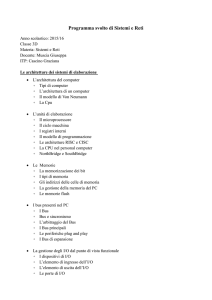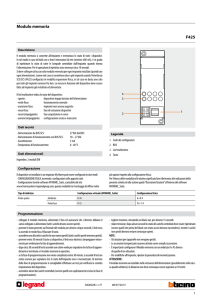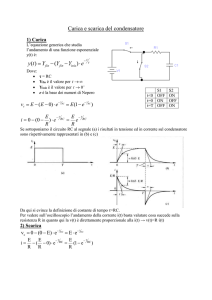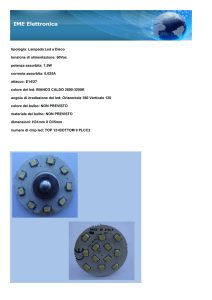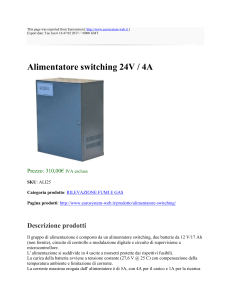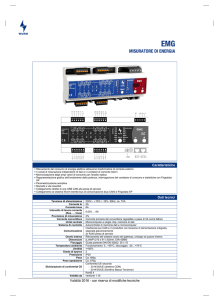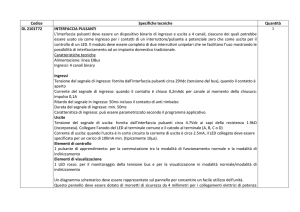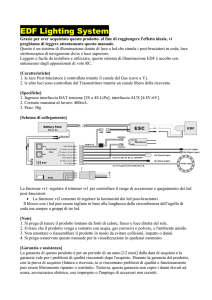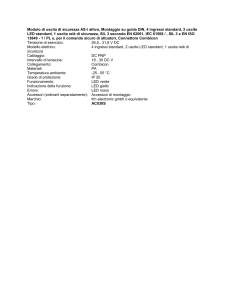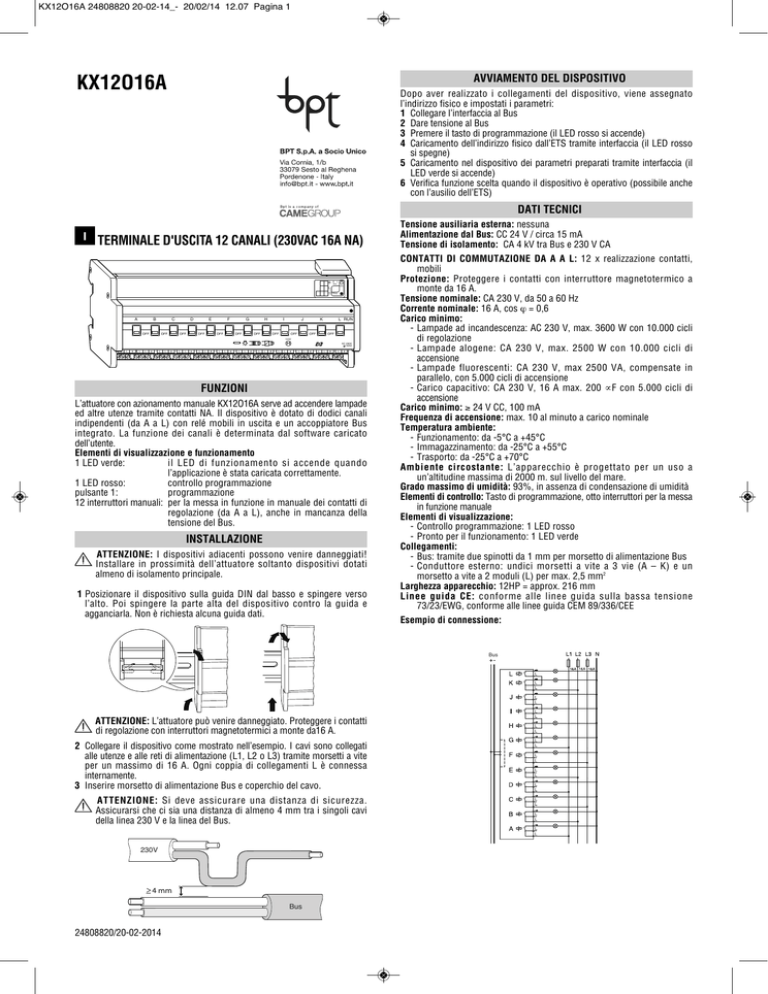
KX12O16A 24808820 20-02-14_- 20/02/14 12.07 Pagina 1
AVVIAMENTO DEL DISPOSITIVO
KX12O16A
Dopo aver realizzato i collegamenti del dispositivo, viene assegnato
l’indirizzo fisico e impostati i parametri:
1 Collegare l’interfaccia al Bus
2 Dare tensione al Bus
3 Premere il tasto di programmazione (il LED rosso si accende)
4 Caricamento dell’indirizzo fisico dall’ETS tramite interfaccia (il LED rosso
si spegne)
5 Caricamento nel dispositivo dei parametri preparati tramite interfaccia (il
LED verde si accende)
6 Verifica funzione scelta quando il dispositivo è operativo (possibile anche
con l’ausilio dell’ETS)
DATI TECNICI
I
TERMINALE D'USCITA 12 CANALI (230VAC 16A NA)
B +Bus-L
T
A
B
C
OFF
L
L
L
OFF
L
L
D
E
OFF
OFF
L
L
L
L
F
OFF
L
G
OFF
L
L
H
OFF
L
L
I
OFF
L
L
J
K
OFF
L RUN
OFF
1000W
L
L
L
ON
Prog.
OFF
L
L
L
AC 230V
16AX
FUNZIONI
L’attuatore con azionamento manuale KX12O16A serve ad accendere lampade
ed altre utenze tramite contatti NA. Il dispositivo è dotato di dodici canali
indipendenti (da A a L) con relé mobili in uscita e un accoppiatore Bus
integrato. La funzione dei canali è determinata dal software caricato
dell’utente.
Elementi di visualizzazione e funzionamento
1 LED verde:
il LED di funzionamento si accende quando
l’applicazione è stata caricata correttamente.
1 LED rosso:
controllo programmazione
pulsante 1:
programmazione
12 interruttori manuali: per la messa in funzione in manuale dei contatti di
regolazione (da A a L), anche in mancanza della
tensione del Bus.
INSTALLAZIONE
ATTENZIONE: I dispositivi adiacenti possono venire danneggiati!
Installare in prossimità dell’attuatore soltanto dispositivi dotati
almeno di isolamento principale.
1 Posizionare il dispositivo sulla guida DIN dal basso e spingere verso
l’alto. Poi spingere la parte alta del dispositivo contro la guida e
agganciarla. Non è richiesta alcuna guida dati.
Tensione ausiliaria esterna: nessuna
Alimentazione dal Bus: CC 24 V / circa 15 mA
Tensione di isolamento: CA 4 kV tra Bus e 230 V CA
CONTATTI DI COMMUTAZIONE DA A A L: 12 x realizzazione contatti,
mobili
Protezione: Proteggere i contatti con interruttore magnetotermico a
monte da 16 A.
Tensione nominale: CA 230 V, da 50 a 60 Hz
Corrente nominale: 16 A, cos ϕ = 0,6
Carico minimo:
- Lampade ad incandescenza: AC 230 V, max. 3600 W con 10.000 cicli
di regolazione
- Lampade alogene: CA 230 V, max. 2500 W con 10.000 cicli di
accensione
- Lampade fluorescenti: CA 230 V, max 2500 VA, compensate in
parallelo, con 5.000 cicli di accensione
- Carico capacitivo: CA 230 V, 16 A max. 200 µF con 5.000 cicli di
accensione
Carico minimo: ≥ 24 V CC, 100 mA
Frequenza di accensione: max. 10 al minuto a carico nominale
Temperatura ambiente:
- Funzionamento: da -5°C a +45°C
- Immagazzinamento: da -25°C a +55°C
- Trasporto: da -25°C a +70°C
Ambiente circostante: L’apparecchio è progettato per un uso a
un’altitudine massima di 2000 m. sul livello del mare.
Grado massimo di umidità: 93%, in assenza di condensazione di umidità
Elementi di controllo: Tasto di programmazione, otto interruttori per la messa
in funzione manuale
Elementi di visualizzazione:
- Controllo programmazione: 1 LED rosso
- Pronto per il funzionamento: 1 LED verde
Collegamenti:
- Bus: tramite due spinotti da 1 mm per morsetto di alimentazione Bus
- Conduttore esterno: undici morsetti a vite a 3 vie (A – K) e un
morsetto a vite a 2 moduli (L) per max. 2,5 mm2
Larghezza apparecchio: 12HP = approx. 216 mm
Linee guida CE: conforme alle linee guida sulla bassa tensione
73/23/EWG, conforme alle linee guida CEM 89/336/CEE
Esempio di connessione:
Bus
ATTENZIONE: L’attuatore può venire danneggiato. Proteggere i contatti
di regolazione con interruttori magnetotermici a monte da16 A.
2 Collegare il dispositivo come mostrato nell’esempio. I cavi sono collegati
alle utenze e alle reti di alimentazione (L1, L2 o L3) tramite morsetti a vite
per un massimo di 16 A. Ogni coppia di collegamenti L è connessa
internamente.
3 Inserire morsetto di alimentazione Bus e coperchio del cavo.
ATTENZIONE: Si deve assicurare una distanza di sicurezza.
Assicurarsi che ci sia una distanza di almeno 4 mm tra i singoli cavi
della linea 230 V e la linea del Bus.
230V
Bus
24808820/20-02-2014
KX12O16A 24808820 20-02-14_- 20/02/14 12.07 Pagina 2
KX12016A
STARTING UP THE DEVICE
After wiring the device, the physical address is allocated and the
parameters are set:
1 Connect interface to Bus
2 Switch on Bus voltage
3 Press the programming key (red LED lights up)
4 Loading of physical address from the ETS via interface (red LED goes
out)
5 Loading of prepared parameterisation into the device via interface (green
LED lights up)
6 Test chosen function when device is operational (also possible with the
aid of the ETS)
EN
TECHNICAL DATA
External auxiliary voltage: none
Supply from Bus: DC 24 V / approx. 15 mA
Insulation voltage: AC 4 kV between Bus and 230 V AC
BINARY OUTPUT 12 CHANNELS 16A
B +Bus-L
T
A
B
C
OFF
L
L
L
OFF
L
L
D
E
OFF
OFF
L
L
L
L
F
OFF
L
G
OFF
L
L
H
OFF
L
L
I
OFF
L
L
J
K
OFF
L
L RUN
OFF
1000W
L
L
ON
Prog.
OFF
L
L
L
AC 230V
16AX
FUNCTIONS
The switching actuator wilh manual actuation is for switching lamps and
other users via make contacts. The device is equipped with twelve
independent channels (A to L) with floating relay outputs and an integrated
Bus coupler. The function of the channels is determined by the loaded user
software.
Display and operating elements
1 green LED:
operating LED lights up when the applicati-on has been
loaded correctly.
1 red LED:
programming control
1 button:
programming
12 hand switches: for manual operation of the switching contacts (A to L),
even in the absence of Bus voltage.
INSTALLATION
WARNING: Adjacent devices may get damaged! Only install devices
with at least a basic insulation next to the switching actuator.
1 Place the device into the DIN rail from below and push upwards. The
push the top of the device against the rail and hook it in. No data rail is
required.
SWITCHING CONTACTS A TO L: 12 x make contacts, floating
Protection: Protect the switching contacts with upstream 16 A circuit
breaker
Nominal voltage: AC 230 V, 50 to 60 Hz
Nominal current: 16 A, cos ϕ = 0,6
Connected load:
- Incandescent lamps: AC 230 V, max. 3600 W with 10,000 switching
cycles
- Halogen lamps: AC 230 V, max. 2500 W with 10,000 switching cycles
- Fluorescent lamps: AC 230 V, max 2500 VA, parallel-compensated,
with 5,000 switching cycles
- Capacitive load: AC 230 V, 16 A max. 200 µF with 5,000 switching
cycles
Minimal loads: ≥ 24 V DC, 100 mA
Switching frequency: max. 10 per minute at nominal load
Ambient temperature:
- Operation: -5°C to +45°C
- Storage: -25°C to +55°C
- Transport: -25°C to +70°C
Surroundings: The device is designed for use at an altitude of up to 2000
m above sea level.
Max. humidity: 93%, no moisture condensation
Control elements: Programming key, eight hand switches for manual
operation
Display elements:
- Programming control: 1 red LED
- Readiness of operation: 1 green LED
Connections:
- Bus: via two 1 mm pins for Bus supply terminal
- Outer conductor: eleven 3-gang screw terminals (A - K) and one 2gang screw terminal (L) for max. 2.5 mm2
Device width: 12HP = approx. 216 mm
EC guidelines: complies with low-voltage - guideline 73/23/EWG,
complies with EMC guideline 89/336/EEC
Connection illustrator:
Bus
WARNING: Switching actuator may get damaged. Protect switching
contacts with upstream 16 A circuit breakers.
2 Connect the device as shown in the example. The cables to the users
and the mains voltages (L1, L2 or L3) are connected via screw
terminals for a maximum of 16 A. Each pair of L connections is
connected internally.
3 Plug in Bus supply terminal and cable cover.
WARNING: A safety gap in accordance with DIN VDE 0110. Section 1
must be ensured.Ensure that there is a gap of at least 4 mm between the individual wires of the 230 V line and the Bus line.
230V
Bus

